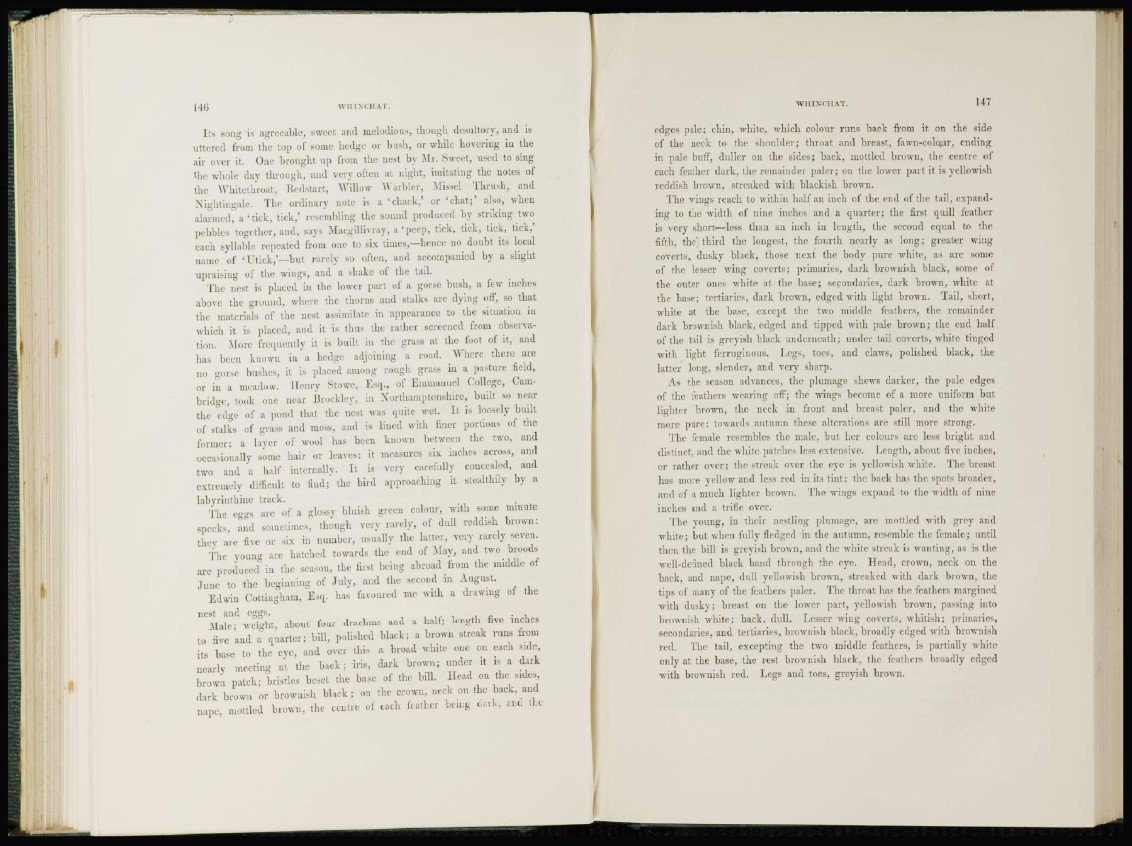
WHINCHAT.
I t s song is agreeable, sweet and melodious, though desultory* and is
uttered from the top of some hedge or bush, or while hovering iu the
air over ir. One brought up from the nest b\ Mr. Sweet, used to sing
the whole day through, and very often at night, imitating the notes of
the White-throat, Redstart, Willow Warbler, Missel Thrush, and
Nightingale. The ordinary note is a ' ehaek,' or ' c h a t ; ' also, when
alarmed, a Mick, tick,' resembling the sound produced by striking two
pebbles together, and, says Macgillivray, a ' p e e p , tick, tick, tick, tick,'
each syllable repeated from one to six times,—hence no doubt its local
name of 'I,tick,'—-but rarely so often, and accompanied bv a slight
upraising of the wings, and a shake of the tail.
The nest is placed in the lower part of a gorse bush, a few inches
above the ground, where the thorns and stalks are dying off, so that
the materials of the nest assimilate in appearance to the situation in
which it is placed, and it is thus the rather screened from observation.
More frequently it is built in the grass at the fool of it, and
has been known in a hedge adjoining a road. \\ here there are
no gorse bushes, it is placed among rough grass in a pasture field,
or in a meadow. Henry Stowe, Esq., of Emmanuel College, Cainbridge,
took one near Brockley, in Northamptonshire, built so near
the edge of a pond that the nest was quite wet. It is loosely built
of stalks of grass and moss, and is lined with finer portions of the
former; a layer of wool has been known between the two, and
occasionally some hair or leaves: it measures six inches across, and
two and a half internally. It is very carefully concealed, and
extremely difficult to find; the bird approaching it stealthily by a
labyrinthine track.
The eggs are of a glossy bluish green colour, with some minute
specks, and sometimes, though very rarely, of dull reddish brown:
they are five or si\ iu number, usually the latter, very randy seven.
'The young are hatched towards the end of May, and two broods
arc produced in the season, the first being abroad from the middle of
June to the beginning of July, and the second in August.
Edwin Cottinghim, Esq. has favoured me with a drawing of the
nest and eggs.
Male; weight, about four drachms and a half; length five inches
to five and a quarter; bill, polished black; a brown streak runs from
its base to the eye, and over this a broad white one on each side,
nearly meeting at the back; iris, dark brown; under it is a dark
brown patch; bristles beset the base of the bill. Head on the sides,
dark brown or brownish black ; on the crown, neck on the back, and
nape, mottled brown, the centre of each feather being dark, and the
w i n x e i i \ T. 117
edges pale; chin, white, which colour runs back from it on the side
of the neck to the shoulder; throat and breast, fawn-colour, ending
in pale buff, duller on the sides; back, mottled brown, the centre of
each feather dark, the remainder paler; on the lower part it is yellowish
reddish brown, streaked with blackish brown.
The wings reach to within half an inch of the end of the tail, expanding
to the width of nine inches and a quarter; the first quill feather
is very short—less than an inch in length, the second equal to the
fifth, the. third the longest, the fourth nearly as long; greater wing
coverts, dusky black, those next the body pure white, as are some
of the lesser wing coverts; primaries, dark brownish black, some of
the outer ones white at the base; secondaries, dark brown, white at
the base; tertiarics, dark brown, edged with light brown. Tail, short,
white at the base, except the two middle feathers, the remainder
dark brownish black, edged and tipped with pale brown; the end half
of the tail is greyish black underneath; under tail coverts, white tinged
with light ferruginous. Tegs, toes, and claws, polished black, the
latter long, slender, and very sharp.
As the season advances, the plumage shews darker, the pale edges
of the feathers wearing off; the wings become of a more uniform but.
lighter brown, the neck in front and breast paler, and the -white
more pure: towards autumn these alterations are still more strong.
The female resembles the male, but her colours arc less bright and
distinct, and the white patches less extensive. Length, about five inches,
or rather over; the streak over the eye is yellowish white. The breast
has more y^ellow and less red in its tint; the back has the spots broader,
and of a much lighter brown. The wings expand to the width of nine
inches and a trifle over.
The young, in their nestling plumage, are mottled with grey and
white; but when fully fledged in the autumn, resemble the female; until
then the bill is greyish brown, and the white streak is wanting, as is the
well-defined black band through the eye. Head, crown, neck on the
back, and nape, dull yellowish brown, streaked with dark brown, the
tips of many of the feathers paler. The throat has the feathers margined
with dusky; breast on the lower part, yellowish brown, passing into
brownish white; back, dull. Lesser wing coverts, whitish; primaries,
secondaries, and tertiarics, brownish black, broadly edged with brownish
red. The tail, excepting the two middle feathers, is partially white
only at the base, the rest brownish black, the feathers broadly edged
with brownish red. Legs and toes, greyish brown.